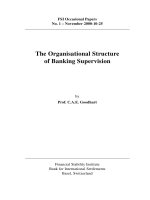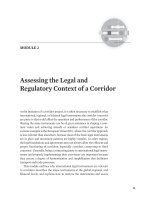Lecture Legal and regulatory aspects of banking supervision – Chapter 3
Bạn đang xem bản rút gọn của tài liệu. Xem và tải ngay bản đầy đủ của tài liệu tại đây (112.81 KB, 29 trang )
Session: Three
MBF-705
LEGAL AND REGULATORY
ASPECTS OF BANKING
SUPERVISION
OSMAN BIN SAIF
1
Summary of Previous Session
•
•
General principles of banking regulation
–
Minimum Requirement
–
Supervisory review
–
Market Discipline
Banking Crises
–
Banking system (Operations, potential Problems,
Criticality)
–
Institutional investors
•
investment banks
•
Pension Funds
•
2
Agenda of this session
•
–
Credit rating agencies
–
Mortgage Brokers
–
Secondary Mortgage Markets
The Mess
–
Evolution of Home Mortgage
–
New model of Mortgage lending
–
Private sub prime mortgage process
–
Reasons for forming of subprime mess
3
Credit Rating Agency (CRA)
•
Company that assigns credit
ratings for issuers of certain types of debt
obligations as well as the debt instruments
themselves
•
A credit rating for an issuer takes into
consideration the issuer's credit
worthiness (i.e., its ability to pay back
a loan), and affects the interest
4
Credit Rating Agency (Contd.)
•
Ex: Moody's (U.S.), Standard &
Poor's (U.S.)
•
Credit ratings are used
by investors, issuers, investment
banks, broker-dealers, and governments.
–
For investors, credit rating agencies increase the range of investment
alternatives and provide independent, easy-to-use measurements of
relative credit risk.
5
Mortgage Broker
•
•
•
Mainly found in developed economies like US,
Western Europe
Professionals who are paid a fee to bring
together lenders and borrowers
Sells mortgage loans on behalf of businesses
(ex. Banks)
6
Mortgage Broker (Contd.)
•
Tasks undertaken:
–
Marketing to attract clients
–
Assessment of the borrowers circumstances
(Mortgage fact find forms interview). This may include
assessment of credit history (normally obtained via a
credit report) and affordability (verified by income
documentation)
–
Assessing the market to find a mortgage product that
fits the clients needs (Mortgage
presentation/recommendations)
7
Mortgage Broker (Contd.)
–
Applying for a lenders agreement in principle
(pre-approval)
–
Gathering all needed documents (paystubs /
payslips, bank statements, etc.),
–
Completing a lender application form
–
Explaining the legal disclosures
–
Submitting all material to the lender
8
Sub-prime mortgage – What’s
that?
•
Home loans made to borrowers with poor
credit ratings — a group generally defined
by FICO scores below 620 on a scale that
ranges from 300 to 850
9
Sub-prime mortgage (Contd.)
•
FICO - a number that is based on a
statistical analysis of a person's credit
report, and is used to represent the
creditworthiness of that person.
(FICO is the acronym for Fair Isaac Corporation, a publicly-traded corporation (under the symbol
"FIC") that created the best-known and most widely used credit score model in the US.)
•
Creditworthiness—the likelihood that the
person will pay his or her debts.
Calculated by credit reporting agencies.
Ex. Equifax, Experian, and TransUnion
in
10
Secondary Mortgage markets
•
•
The secondary mortgage market allows
banks to sell mortgages, giving them new
funds to offer more mortgages to new
borrowers.
If banks had to keep these mortgages the
full 15 or 30 years, they would soon use
up all their funds, and potential
homebuyers would have a more difficult
time to find mortgage lenders.
11
Secondary Mortgage markets
(Contd.)
•
•
Many of the mortgages on the secondary
market are bought by Fannie Mae.
Other are packaged into mortgage-backed
securities, and sold to investors.
12
Now we are ready to look into
the mess !
13
Evolution of home mortgage
Home loan funding
1930s
Principal + interest payable over long term
Lender-Banks
•
•
Borrower-Individuals
Owning a house was not affordable to many
Great Depression brought industry to a halt. Large scale defaulters and lenders
could not recover by reselling
14
•
Evolution of home mortgage
(Contd.)
To simulate the industry again
Government as part of New Deal policy created
the Federal National Mortgage Association (Fannie Mae) in 1938. This created a
secondary market for mortgages
Bought loan
Home loan funding
Principal + interest payable
over long term
Cash
Transfer of credit risk, market risk
Had Access to long term borrowing
Lender-Banks
Borrower-Individuals
Bought only those which conformed to certain
underwriting standard ( called Prime Mortgages)
15
Evolution continued…
•
Fannie Mae proved very successful . But by 1960s ,
borrowing done by it constituted a significant share of the
debt owed by US government.
•
1968- Government National Mortgage Association
(Ginnie Mae) was created to handle government
guaranteed mortgages.
•
Fannie Mae became federally chartered, privately held
16
Evolution continued
•
1970- Ginnie Mae developed MBS (Mortgage
backed by Securities) -- shifted the market risk
to investors -- eliminated debt incurred to fund
government housing program
•
1970-Federal National Mortgage Corporation
(Freddie Mac) created
–
To securitize conventional mortgages
–
Provide competition to Fannie Mae17
Evolution Continued
•
Over time Fannie Mae and Freddie Mac
together provided enormous amount of
funding for US mortgage
•
Since Fannie Mae and Freddie Mac
guaranteed loans, much of credit risk
stayed with them. Size and diversification
allowed them to handle it.
18
New Model of mortgage lending
Bought loan
Home loan funding
Cash
Securitization
fees
SPV
MBS
Cash
Transfer of credit & market risk
Lender-Banks
Principal + interest payable
over long term
Transfer of market risk
19
New Model of mortgage lending
(Contd.)
•
Advantages
•
More liquidity in market
•
Risk spread out
•
Long term funding for mortgage lending
•
MBS- allows originators to earn fee income
from underwriting activities without exposure
to credit, market or liquidity risks as they see
the loans they make
20
Further evolution..
•
1977- Private label securitization started
first done by BOA and Salomon Brothers
•
1980s- pricing, liquidity and tax hurdles
were resolved in same
•
Unlike 2-3 party , private label
securitization has 10 or more different
parties playing independent role
21
Further evolution
•
Big private players in this field were
–
Wells Frago
–
Lehman Brothers
–
Bear Stearns
–
JP Morgan
–
Goldman Sachs
–
Bank Of America
22
Details : Private Sub-prime
mortgage process
•
•
•
•
•
1. Brokers identify borrowers
2. Originator and broker identify a loan for
borrower after looking at his credit rating
3. Formal application for loan by borrower
4. Originator transfers the loan to the
subsidiary of an investment banking firm
( Seller)
5. Seller(Investment bank) collects a pool
23
of loans and call it as SPV. Off balance
Details : Private Sub-prime
mortgage process (Contd.)
•
•
•
6. SPV can be a corporation, partnership
or limited liability company. Most often a
Trust. It has nothing else except mortgage
loans
7. Underwriter purchases all the securities
(derivative income streams)
8. In designing SPV and its tranches
underwriter works with credit rating
agencies
24
Details : Private Sub-prime
mortgage process (Contd.)
•
•
•
•
9. Underwriter then sells the securities to
the investors
10. High rated tranches might be
guaranteed by a 3rd party insurance
company
11. Seller also arranges to sell the rights
to service the loan pool to a company or
sometimes Originator takes these rights
12. MERS – document custodian.
25









